| The
South Staffordshire Tramways (Lessee) Company Limited. |
| The Company Matures In 1901 the
South Staffordshire Tramways (Lessee) Company Limited
purchased its first four tramcars from the Electric Railway
& Tramway Carriage Works Limited, at Preston, a subsidiary
of Dick, Kerr & Company. They were double deck cars which
would have been painted in the company's Munich lake and
cream livery.
In 1901 Emile Garcke was still Chairman. The directors
were: John S. Raworth, William
Somers Schuster, and Samuel Richardson Blundstone. James Lycett
was Managing Director, and W. F. Cox, Company Secretary. Mr.
H. Hartley was Power House Superintendent. A new appointment
was Mr. George Conaty who succeeded Mr. J. J. Robins as
General Manager. Towards the end of 1901 John S. Raworth
resigned and was replaced by Sir Ernest Spencer, M.P.
The employees were as
follows: 10 - clerks, 18 - foremen and inspectors, 98 -
drivers, conductors, and brakesmen, 26 - fitters,
carpenters, enginemen, and firemen, 15 - car washers and
labourers, 18 - permanent way workers, 2 - horse keepers, 4
- blacksmiths, and 40 - others.
During 1901 the company's licence to operate steam trams
was twice extended. It had been a reasonable year, the total
revenue amounted to £41,443 which after deductions left a
profit of £5,807. A total of 6,861,683 passengers were
carried, and tenders were invited for twelve double deck
tramcars to operate on the West Bromwich lines when they had
been electrified.
|
|
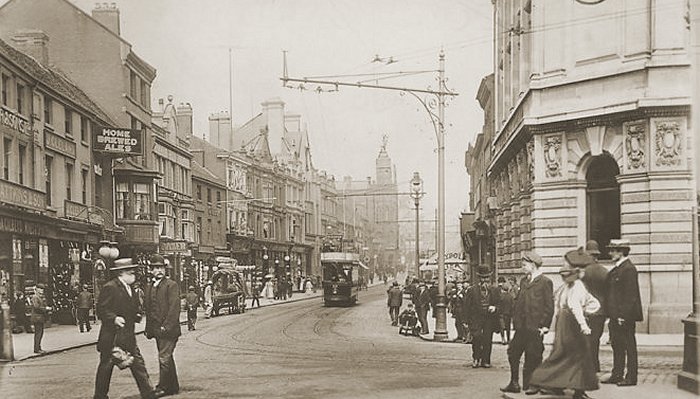
A South Staffs' tram makes it's
way along Park Street, Walsall in about 1900. From an
old postcard. |
| As in the previous year, the licence to operate the steam
trams was twice extended, this time up until April 1903.
Five more tramcars of the 'Baltimore' type were ordered from
the Electric Railway & Tramway Carriage Works Limited, and
Mr. George Conaty left to
become Manager of the City of Birmingham Tramways
Company. He was replaced by Mr. H. Hartley, previously Power
House Superintendent, a role now taken over by Mr. F. J.
Smith. Mr. H. S. Hodgson became Traffic Manager. In August 1902 eighteen
double deck tramcars were ordered from the Brush Electrical
Engineering Company at Loughborough to run on the
electrified West Bromwich lines, which would soon be in
operation. The company's fleet, as listed in the Board of
Trade return on 30th June, 1903 consisted of 33 electric
tramcars and 26 steam locomotives. Shortly afterwards a
special single deck tram arrived from Brush. It had been
ordered by BET for ceremonial occasions.
|

Walsall Corporation Tramways' tramcar
number 41 turns into Bescot Road, from Wednesbury Road in
1930, on its way to Darlaston. |
Late in 1902 the company
decided to promote a Bill for the building of a new tramway
from Great Bridge to Ocker Hill, at the suggestion of Tipton
Urban District Council, and to require Wednesbury Council,
if it decided to take up its option of compulsorily
purchasing the company's lines in the Borough, to lease them
to the company, or to grant the company running powers over
them, and also over lines in Handsworth and Walsall. |
| As agreement couldn't be
reached between Tipton Council and the company, over the
building of the new line, it was dropped from the Bill,
which became law in 1903 as the South Staffordshire Tramways
Act, 1903. |
| Darlaston depot became a
sizeable undertaking as can be seen from the following list
of buildings produced for insurance purposes in October
1903: Car Sheds, Electrical
Fitting Shop, Engine Sheds, Erecting Shop, Machine Shop,
Blacksmiths', Copper Smiths', and Boilermakers' Shop, Repair
Shop and Paint Shop, Sand Drying Chamber with water tank and
Offices, General Stores, Storekeeper's Office and Stables,
Harness Room, Armature Shop, Drawing Office and Wood Pattern
Store, Offices and Store (former Manager's House), Coke
Stores, and Coke Foreman's Office and Weigh House. There
were also several brick and corrugated steel buildings which
housed the Coke Shop, Permanent Way Shop, Smith's Shop, and
Permanent Way Tool Stores. |
|
| At the time, the company
owned 47 electric tramcars, 18 steam locomotives, 17 cars
for the steam locomotives, 5 wagons, 4 coal trucks, and 1
horse. In 1903 the trams carried
9,577,023 passengers, with traffic receipts of £48,923.
On 23rd April, 1903 services operated by Wolverhampton
Corporation Tramways began to run over the Moxley to
Darlaston line.
An extension to the licence
to operate steam trams until April 1904 was granted by the
Board of Trade. At the beginning of 1904 the only parts of
the company's network still operated by steam were the
Wednesbury to Darlaston route, and the Wednesbury to Dudley
line via Tipton, which was seriously affected by mining
subsidence. Because of this problem it was considered to be
unsuitable for electrification because of safety fears.
|
|
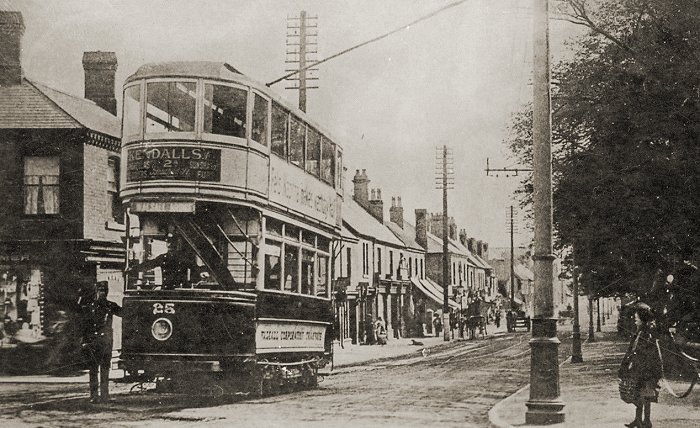
Walsall Corporation's tram number
5 in High Street, Walsall Wood. From an old postcard. |
| Wednesbury and Tipton
Councils contacted the Board of Trade to say that the local
inhabitants would prefer to be without the steam trams, even
though this would mean the loss of the two services. By this
time the company was running the steam services at a loss,
they were only maintained for the convenience of the public.
Although the steam licence had been extended again until
23rd October, the services were terminated on 15th June,
1904, and both lines remained idle for some time. The
company's last steam locomotive to remain in use was based at the
Handsworth depot, and used for shunting cars. It continued in use
until 30th September, 1904. Wednesbury Council finally
agreed to purchase and pay for all the lines in the Borough,
and electrify and refurbish them. In the agreement made on
22nd June, 1905 the council paid £17,420 for the tramways,
excluding the Darlaston to James Bridge line, and the
Darlaston to Moxley line. The lessee company purchased
Darlaston depot for £11,500. Work then began on the
Wednesbury to Darlaston line which reopened on 26th
September, 1905.
In August 1905 an agreement
was finally made between Tipton Urban District Council and
the company, over the Wednesbury to Dudley via Tipton line.
Work soon began to refurbish and electrify the line,
including dealing with the subsidence. An agreement was
reached with Dudley Council over the cost of the Tipton Road
section, and the line reopened on 14th October, 1907.
In 1905, as listed in the
company's annual report, 7,782,261 passengers were carried,
traffic receipts amounted to £39,209, and the company made a
loss of £920.
|
|
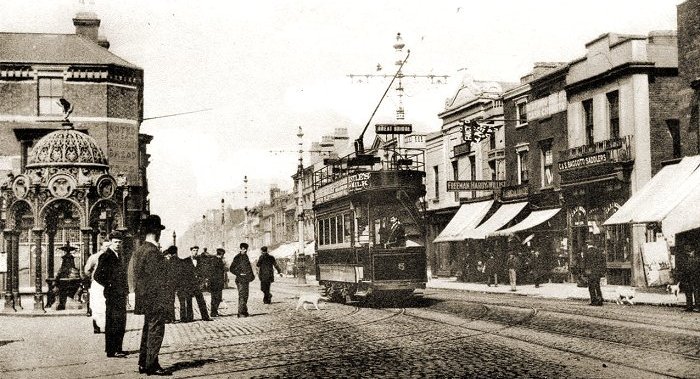
A tram makes its way through
Dartmouth Square, West Bromwich in about 1910. From an
old postcard. |
| In June 1906 the Walsall
Corporation Transport Committee entered into negotiations
with the company to try and improve the service on the
Walsall to Darlaston, and Walsall to Wednesbury routes by
reconstructing the the tramway from The Bridge to Oxford
Street, Pleck with double track. The Corporation also wanted
to add loops at Pleck junction to both the Wednesbury and
Darlaston lines, and renew the electrical equipment. In
return the company had to agree to reconstruct the lines
from Pleck junction to Wednesbury and Darlaston, and pay a
fixed annual sum of £500, and an annual rent of £378. An agreement was made and
work commenced in November 1906, but was held-up by severe
winter weather. Running eventually commenced on 19th March,
1907.
1906 had been a slightly
better year. The number of passengers increased to
8,530,666, and traffic receipts amounted to £43,257. There
were now 174 staff as follows:
Traffic:
7 clerks, 10 inspectors, 87 drivers and conductors, 2 boys,
and 8 parcel boys.
Repairs:
1 clerk, 3 foremen, 2 storekeepers, 20 blacksmiths and
fitters, 2 carpenters, 1 linesman, 6 car washers, 3
painters, 9 permanent way men, and 9 labourers.
Power Station:
4 enginemen and firemen.
There were now 18.19 miles
of track, and improved returns for 1907. The passenger
number was up to 9,320,602, and the traffic receipts
totalled £47,047. Unfortunately the company did not do so
well in 1908. The number of passengers fell to 8,859,415 and
traffic receipts fell to £45,931. The annual profit was just
£39. Speaking at the company's annual meeting, Mr. William
Somers Schuster, now Company Chairman, said that the
overdraft was now £2,383 as against £64 in 1907. He said that
the anticipation that the electrification and the linking-up
of various sections would provide a considerable increase in
traffic, had not materialised. He complained about the
'harassing tactics' of local authorities which added to the
running expenses and everything else. Mr. Cecil Braithwaite
said that he attributed the present position of the company
to 'bullying' by the local authorities, which had caused the
destruction of tramway companies all over the Kingdom.
|
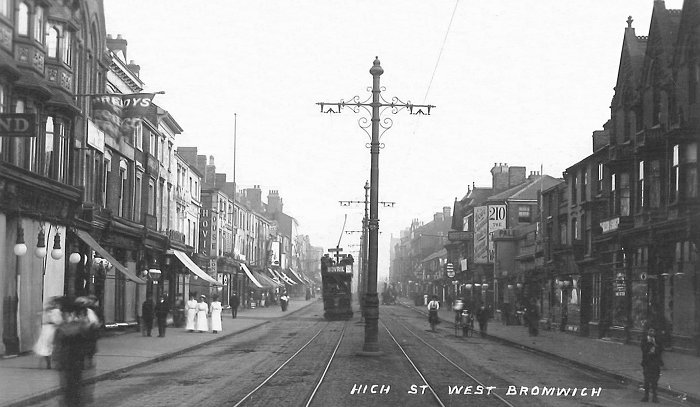
A tram makes its way along West
Bromwich High Street around the turn of the 20th
century. From an old postcard. |
| Unfortunately the squabbles
continued. In July 1909 West Bromwich Corporation complained
that the company had not complied with the agreement made in
December 1905 in which it promised to take, and pay for a
minimum of 900,000 units of electricity per year. The
controversy was not settled until March 1911 when the
company agreed to pay for 600,000 extra units at prices from
one to two pence per unit. This gave the Corporation an
extra income of several thousand pounds.
In the middle of 1909
Handsworth Urban District Council complained about the
company's failure to adequately maintain, clean, and light
the vehicles. The council also wanted to approve any new
vehicles before they were purchased. Things came to a head
on 11th September, 1909 when a tramcar ran away on the
Holyhead Road. Luckily without injury or damage. When
inspected, it was found that one of the four brake blocks was
missing, and the other three did not work correctly.
The council also complained
about a lack of punctuality, arriving at intervals of 7½
minutes instead of 5 minutes, and a lack of maintenance at
Handsworth depot, which was badly in need of a coat of paint. The
council demanded that its tramway expert, Mr. G. Conaty
should have access to the trams and examine them at will.
The dispute would go on for a long time.
1909 was another bad year,
which ended with a loss of £1,493 in spite of the passenger
numbers rising to 9,118,337.
On 1st January, 1910 a new system of fares and stages was
introduced on all the local tramways called the "Fair Fare
System". It took a while for it to be accepted by many
members of the public, and initially led to complaints and
protest meetings. It eventually became accepted after a
number of slight modifications were made.
Some of the complaints made by local authorities to the
company were petty in the extreme. In 1910 Walsall
Corporation insisted that the company must run three covered
cars on the Walsall routes to equal the number of covered
cars purchased by the Corporation, in order to comply with
an agreement made in 1906. At the time the company only had
one such tram, but the others were soon purchased. The
company also acquired a number of covered cars from
Dudley and Stourbridge tramways, after an accident which
resulted in the Board of Trade banning their use on nearly
all the company's routes.
In 1911 Handsworth became part of Birmingham, and the
tramways were taken over by Birmingham Corporation. On 9th
October, 1912 a new through service was introduced between
Darlaston Bull Stake and Colmore Row in Birmingham. It
became known as the 'Black Country Through Service'.
On 26th May, 1923 the service was extended to Bilston, over
Wolverhampton Corporation's tracks.
|
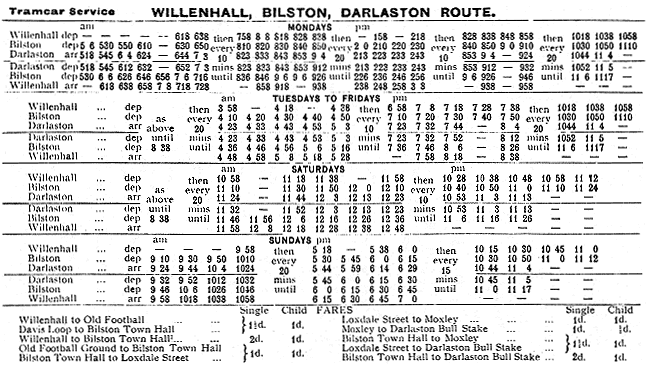
A Wolverhampton Corporation 1928 timetable.
|
In 1916
reduced services were operated in the evenings after the
Zeppelin raids, as a result of the destruction of tramcar 16
on 31st January, 1916 in Bradford Place, Walsall. A bomb
damaged the tramcar, and a passenger, Walsall's Mayoress,
Mrs. Mary Julia Slater
was severely injured and died in hospital on 20th February.
In 1920 to 1921 the route
from Pinfold to Bloxwich was improved, and in 1922 Walsall
Corporation took over responsibility for the lines from Pleck to Wood Green and Darlaston.
The South Staffordshire lines continued
to operate in West Bromwich, Wednesbury and Dudley until 1st
April, 1924, when the West Bromwich lease expired, and
Birmingham was approached to operate the routes between
Birmingham, Dudley and Wednesbury, on behalf of West
Bromwich Corporation. The Wednesbury to Dudley route was
taken over by the Dudley, Stourbridge and District Electric
Traction Company, and the remaining routes were taken over
by Wolverhampton Corporation Tramways. The South
Staffordshire Tramways (Lessee) Company Limited finally
ceased to operate on 22nd December, 1931. |
 |
|
 |
Return to
A Rocky Road |
|
Return to the
S. Staffs menu |
|